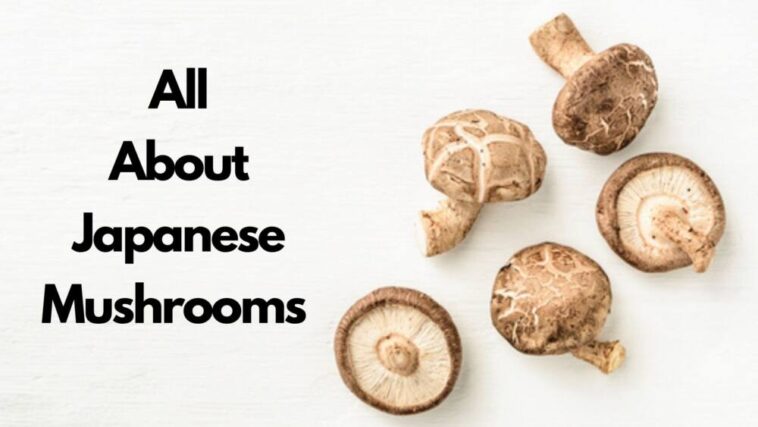Here’s a list of Japanese mushrooms you have to try! Check it out!
Mushrooms are one of the most essential ingredients in Japanese cuisine. There is not just one type of mushroom; there is a wide range of variety that you can choose from. I love mushrooms and how versatile they are.
Using them in different dishes can really elevate the taste and add the Japanese umami flavor.
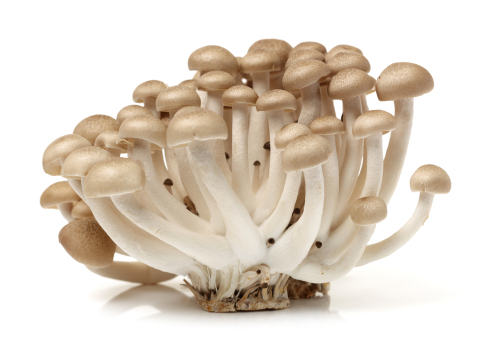
I have tried to put together some of the most popular and the most delicious Japanese mushrooms on this list. I hope you can find your next favorite Japanese ingredient for almost all of your dishes.

What are mushrooms?
Mushrooms are a part of the fungus family. To be more specific, a mushroom is the fleshy and fruity form of a fungus. While all mushrooms are fungi, not all fungi are mushrooms. A mushroom usually comes with stems and caps and they also have gills.
Gills are nothing but the little frills that we see on the underside of the mushroom’s cap. These gills are used to produce spores, which help us produce more fungi.
Also Read: List of Japanese mushrooms
List of Japanese Mushrooms — Quick Summary
| List of Japanese Mushrooms | Nutrients | Health Benefits |
| Shiitake | Vitamin B Phosphorus Vitamin D Potassium | Helps lower cholesterol antiviral effect |
| Maitake | Antioxidants fiber vitamin D potassium | Helps lower blood sugar helps boost immune system |
| Eryngii | Carbohydrates protein vitamin B3 Vitamin D | can help prevent tumor and cancer helps to improve blood stimulation |
| Enoki | iron protein copper Vitamin D | helps balance the sugar level can relieve constipation |
| Matsutake | Vitamin B3 vitamin D copper potassium | helps improve the immune system promotes the circulatory system |
| Nameko | Vitamin B copper potassium calcium | helps lower cholesterol helps to increase resistance against staph infections |
| Shimeji | zinc vitamin B protein copper | enhances metabolism lowers cholesterol |
- Related: Are Japanese Peanuts Good for you?
- Related: Are Japanese Spider Crabs Edible
- Related: Are Japanese Plums Edible
Page Contents
List of Japanese Mushrooms
Shiitake
One of the most common types of Mushrooms that is known worldwide is shiitake. The name of this mushroom comes from the tree on whose dead logs they grow. Shiitake is known to be extremely healthy and it is packed with nutrients.
Look wise, they have large brown caps that range from tan to dark in colour. The stems of shiitake mushrooms are white.

Shiitake mushrooms have a very smoky flavor that I absolutely enjoy. When I am preparing shiitake mushrooms at home, I love adding them to soups and stir-fries. You can find shiitake in both its dried and fresh form.
If you are using the dried version of this mushroom, make sure that you soak it for several hours before you are ready to cook it. Before putting the mushrooms in a dish, make sure to dry them completely. If you want to buy fresh shiitake, always check the stems for their tenderness. If the stems are tender, you can leave them on the mushroom. The tougher ones should be removed and can be used to make soup stock.
The versatile shiitake mushrooms are extremely aromatic. I also immensely enjoy the chewy and dense texture and because of this, this can be used as a meat substitute.
Nutrients in shiitake mushrooms:
- Vitamin B
- Phosphorus
- Vitamin D
- Potassium
Health benefits:
- Helps lower cholesterol
- antiviral effect
- Helps stimulate immune cells
- Helps to prevent tumor and cancer
Related: Why Are Japanese Fruits So Expensive
Maitake
My talking is a very funny looking mushroom that is quite popular in Japan. In English, the name of this mushroom translates to “dancing mushroom”. However, do not go by its funny appearance; it is an absolute delicacy that is also very healthy.
These mushrooms are found in Japanese hardwood forests. As opposed to the texture of shiitake mushrooms, Maitake mushrooms have a soft texture. Also, you will not find the usual squeakiness that is one of the major characteristics of several mushrooms.
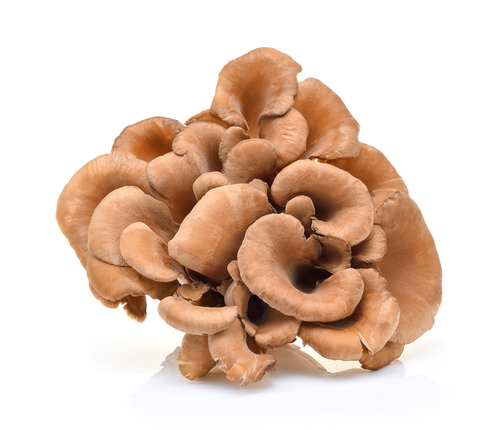
The mushrooms have a white tough base that grows into several feathery leaves. You do not need a knife to pull them apart; you can simply use your fingers to pull it out. I absolutely enjoyed the strong flavour of this mushroom. It has a very early and spicy flavour that makes it the perfect ingredient for sauteing. I also love using these mushrooms for simmering and roasting.
Nutrients in Maitake mushrooms:
- Antioxidants
- fiber
- vitamin D
- potassium
- Vitamin C
- copper
Health benefits:
- Helps lower blood sugar
- helps boost immune system
- promotes heart health
- Helps in weight loss
Related: What is Hakusai?
Eryngii
These mushrooms are also known as King trumpet, King oyster, and French horn. These mushrooms are one of the largest oyster mushrooms available. These mushrooms are not only native to Japan but are also grown in other parts of Asia, Mediterranean Europe, the Middle East, and North Africa.

It is quite easy to recognize this type of mushroom. These mushrooms have a meaty, white stem and the brown cap of these mushrooms is relatively smaller in size. If you ever tried these mushrooms raw, you will realize that there is absolutely no flavor or aroma to them.
However, believe me, when you cook them, they become absolutely healthy and there are a plethora of flavors. I love grilling and broiling these mushrooms, but you can prepare them in several different ways to stop this is especially an extremely perfect option for all of those who are vegetarian and vegan.
Nutrients in Eryngii mushrooms:
- Carbohydrates
- protein
- vitamin B3
- Vitamin D
Health benefits:
- Help to reduce the risk of chronic diseases
- can help prevent tumor and cancer
- helps to improve blood stimulation
- helps with any skin problem
Related: Why Are Mangoes so Expensive in Japan
Enoki
Enoki mushrooms look like little flowers; they are found in clusters and are usually thin, long, and fragile. Enoki mushrooms are one of the most common ingredients used in Japanese dishes. However, they also make very frequent appearances in Korean and Chinese cuisine.
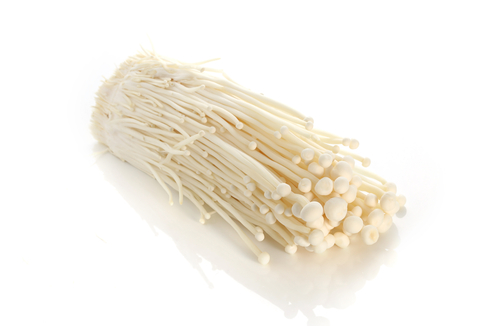
These mushrooms are also known as winter mushrooms because their main season lasts between September and March. Enoki mushrooms can easily be found in any Japanese Supermarket at any time of the year.
If you want to know if the mushrooms are fresh or not, always make sure that you look at their stalks and caps.
If the stalks are slimy and brownish, make sure to avoid them. Always go for Enoki mushrooms that have white and shiny caps because they indicate freshness.
I love the crunchy texture of enoki mushroom and the mild and fruity flavour that compliments that texture. I love making healthy soups and salads out of enoki Mushrooms.
Nutrients in enoki mushrooms:
- Fiber
- vitamin B
- iron
- protein
- copper
- Vitamin D
Health benefits:
- Can help improve immune system
- can help with tumor and cancer resistance
- helps balance the sugar level
- can relieve constipation
Matsutake
If you love mushrooms, you will probably already know about matsuzaki. This type of mushroom is known especially for its spiciness.
These mushrooms grow in Asia, Europe, and North America. However, it can be very difficult for you to find these mushrooms in regular supermarkets. I absolutely love the strong taste and aroma of these mushrooms.
Nutrients in Matsutake mushrooms:
- Vitamin B3
- vitamin D
- copper
- potassium
Health benefits:
- Increases heart health
- can help with tumor and cancer resistance
- helps improve the immune system
- promotes the circulatory system
Nameko
Nameko mushrooms are found in small clusters with orange caps. They have a gelatinous coating. Nameko is extremely popular in Japan, and now this mushroom has its own mobile game called a Mushroom Garden.
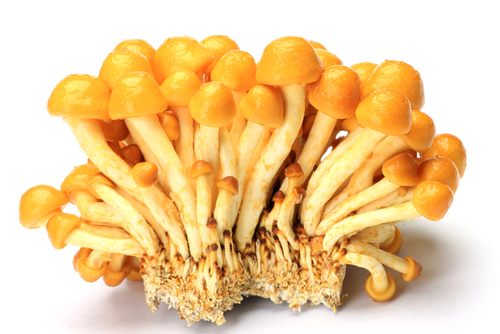
The mushroom is known for its mildly nutty taste that makes it one of the most important ingredients in Japanese cuisine. These mushrooms are often used in stir-fries and noodles. The cap of the mushroom is slimy and so it is used as a thickener for soups. The slime of the mushroom does not add any flavor to the dish.
Nutrients in namica mushrooms:
- Vitamin B
- copper
- potassium
- calcium
Health benefits:
- Can help improve the immune system
- helps lower cholesterol
- helps to increase resistance against staph infections
Shimeji
Shimeji mushrooms are found in different shapes and colors. The taste and texture of all these different variances are the same. The raw mushrooms have a very bitter taste and an unpleasant aroma. However, all of this disappears completely when cooked.
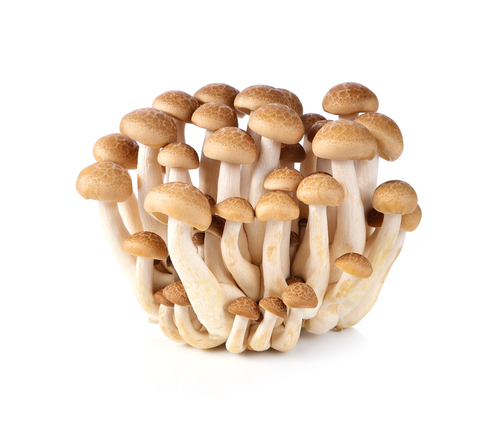
When used in dishes, the mushrooms give a very crunchy texture and a mild nutty flavor. You can use shimeji mushrooms for any kind of this because they are that versatile. You can use them in stir-fries, soups, hotpots, pasta, and seafood.
Types of shimeji Mushrooms:
- Buna Shimeji
- Bunapi Shimeji
- Hatake Shimeji
- Shirotamogidake
Nutrients in shimeji mushroom:
- Potassium
- zinc
- vitamin B
- protein
- copper
- Vitamin D
Health benefits:
- Improve heart health
- improves immune system
- enhances metabolism
- lowers cholesterol
Hiratake mushroom (Oyster mushroom)
The Hiratake mushroom, commonly known as the Oyster mushroom, is a popular edible mushroom species with the scientific name Pleurotus ostreatus.
It is widely cultivated and consumed around the world for its delicate flavor, tender texture, and numerous potential health benefits.
Here’s some information about the Oyster mushroom:
- Appearance
Oyster mushrooms are named for their resemblance to oysters. They have a distinct shell-like or fan-shaped cap that ranges in color from white to gray to pale brown.
The cap can measure anywhere from a few centimeters to around 20 centimeters (8 inches) in diameter.
The stem of the Oyster mushroom is often off-center and can be short or long, depending on the specific variety.
- Cultivation
Oyster mushrooms are relatively easy to cultivate and are often grown commercially. They can be grown on a variety of substrates, including straw, sawdust, wood chips, and even coffee grounds.
They thrive in moderate temperatures and require high humidity levels. Oyster mushrooms are known for their rapid growth, and under optimal conditions, they can mature within a few weeks.
- Flavor and Culinary Uses
Oyster mushrooms have a mild, delicate flavor with a slightly nutty undertone. Their tender texture makes them versatile for various culinary applications.
They can be sautéed, grilled, stir-fried, added to soups, stews, and pasta dishes, or used as a pizza topping. Oyster mushrooms are often used in vegetarian and vegan cooking as a meat substitute due to their meaty texture.
- Nutritional Benefits
Oyster mushrooms are not only delicious but also offer several potential health benefits. They are low in calories and fat, making them a good choice for those looking to maintain a healthy diet.
Additionally, Oyster mushrooms are a good source of protein, dietary fiber, B-vitamins (such as B1, B2, B3, and B5), and essential minerals like potassium, phosphorus, and iron. They also contain compounds with potential antioxidant and immune-boosting properties.
- Medicinal Potential
Oyster mushrooms have a history of use in traditional medicine, particularly in Asian cultures.
They are believed to possess certain medicinal properties, including immune system support and potential anti-inflammatory effects.
Some studies have suggested that Oyster mushrooms might have antiviral and antibacterial properties as well.
- Wild Varieties
Apart from the cultivated variety (Pleurotus ostreatus), there are many wild species of Oyster mushrooms found in different parts of the world.
Some of these wild species are also edible and can be foraged, but caution is always advised when consuming wild mushrooms due to the risk of misidentification.
In conclusion, the Oyster mushroom (Hiratake) is a popular and widely cultivated edible mushroom known for its mild flavor, versatile culinary uses, and potential health benefits.
Whether enjoyed in a stir-fry, a hearty soup, or any other dish, Oyster mushrooms are a delightful addition to the world of cuisine.
Kikurage (Cloud ear mushroom)
Kikurage, also known as Cloud Ear mushroom, is a type of edible fungus that is commonly used in Asian cuisine, particularly in Chinese and Japanese dishes. Its scientific name is Auricularia polytricha. This mushroom gets its name from its unique appearance, as its thin, translucent, and wavy-edged caps resemble delicate cloud ears.
Here are some key details about Kikurage (Cloud Ear mushroom):
- Appearance
Kikurage mushrooms have thin, gelatinous, and dark-brown to blackish-brown caps. The caps are typically small and range in size from about 3 to 8 centimeters (1 to 3 inches) in diameter.
Their shape is often irregular, resembling a folded or crumpled ear, which is where the common name “Cloud Ear mushroom” comes from.
- Texture and Taste
The texture of Cloud Ear mushrooms is quite unique. When rehydrated, they become soft and gelatinous, and their thin caps take on a slightly crunchy yet chewy texture.
They are mostly used for their interesting texture rather than for their flavor, as they have a very mild taste that tends to absorb the flavors of the dishes they’re cooked with.
- Culinary Uses
Kikurage mushrooms are highly valued for their texture and versatility in Asian cooking. They are often used in dishes like soups, stir-fries, hot pots, and salads.
Due to their neutral flavor, Cloud Ear mushrooms are excellent at absorbing the flavors of the other ingredients in a dish, making them a popular addition to many recipes.
- Preparation
Dried Cloud Ear mushrooms are widely available and need to be rehydrated before use. To rehydrate, they are typically soaked in warm water for about 20 to 30 minutes until they become soft and pliable.
After rehydration, the mushrooms are often trimmed to remove any tough or hard portions before being added to dishes.
- Nutritional Profile
Kikurage mushrooms are low in calories and fat, making them a healthy addition to various dishes. While they are not particularly nutrient-rich, they do provide some dietary fiber and small amounts of minerals.
- Cultural Significance
Cloud Ear mushrooms have been used for centuries in traditional Asian medicine for their perceived health benefits, including their potential to support healthy skin and circulation.
However, scientific research on these potential health effects is limited.
In summary, Kikurage, or Cloud Ear mushroom, is an intriguing and popular ingredient in Asian cuisine known for its unique appearance, gelatinous texture, and versatility in a wide range of dishes.
Why are Japanese mushrooms so flavourful?
Mushrooms have an umami flavor. Umami means nothing but the deliciousness of the mushroom; it has a very rich and savory flavor. When you cook Japanese mushrooms, they bring out a very chewy and crispy texture. Many of them have an earthy and woody taste whereas others are mild and sweet.
It adds a distinctive texture and visual appeal to soups, stir-fries, salads, and other culinary creations.
Facts about Japanese mushrooms
- Out of over 5,000 varieties of mushrooms available in Japan, about 100 varieties can be eaten.
- Mushrooms are known as kinoko in Japanese.
- The most common varieties of Mushrooms readily available in the market include Nameko, Shiitake, Matsutake, and Maitake.
- Mushrooms are known to be one of the most staple ingredients in Japanese cuisine.
Nutritional value of Japanese mushrooms
Japanese mushrooms are known to be highly nutrient-dense and full of excellent health benefits. These mushrooms are an excellent source of vitamin D, potassium, zinc, iron, manganese, and amino acids.
How to choose Japanese mushrooms and how to store them?
When you go to the supermarket to buy mushrooms, make sure that they are dry. There is, however, a difference between dry and withered mushrooms. Never go for mushrooms that look withered. If the mushrooms have been wrapped in plastic, look for any signs of condensation.
When you are storing your mushrooms, store them in a paper bag. This will prevent the mushrooms from getting too wet or too dry. If you are like me and if you like storing your stock in plastic wrap terms it always helps to poke a few holes. Even with this make sure that you use the mushroom within a few days. Do not wash the mushrooms before storing them; do this only when you are about to use them.
Japanese Mushrooms: FAQs
Are Enoki mushrooms healthy?
Enoki mushrooms are extremely rich in vitamins and minerals and healthy amino acids. If you are following a healthy diet, this is a very good addition that you can make.
These mushrooms are also low in cholesterol and high in dietary fiber; you will also find that enoki mushrooms are quite rich in antioxidants.
These mushrooms have been used for centuries to make Asian medicines. It is believed that medicines made from these mushrooms are used to treat high blood pressure, high cholesterol, liver disease, and stomach ailments.
How do the Japanese eat mushrooms?
Mushrooms are one of the most used food items in Japan. It is believed that mushrooms are extremely important to strengthen the immune system and it is also true that they have cancer-fighting properties as well as antioxidants.
The Japanese love their mushrooms in miso soup or with Soba noodles. Mushrooms are also a very common addition to hot pots.
What is the most popular mushroom in Japan?
The most popular mushroom in Japan is shiitake. It is known for its meaty texture and umami flavor.
Shiitake mushrooms are available fresh or dried, and they are used in a variety of dishes, such as soups, stir-fries, and tempura.
Here are some other popular mushrooms in Japan:
- Maitake mushrooms: Also known as “hen of the woods,” maitake mushrooms have a large, fan-shaped cap and a delicate flavor. They are often used in tempura or stir-fries.
- Enoki mushrooms: These small, white mushrooms have a crunchy texture and a mild flavor. They are often used in soups and salads.
- Shimeji mushrooms: Also known as “beech mushrooms,” shimeji mushrooms have a short, slender stem and a cap that can be white, brown, or yellow. They have a slightly sweet flavor and are often used in stir-fries.
- Nameko mushrooms: These small, orange mushrooms have a jelly-like texture and a mild flavor. They are often used in soups and salads.
How many species of mushrooms are in Japan?
There are estimated to be between 4,000 and 5,000 different species of mushrooms in Japan. Of these, only about 100 are edible.
The humid climate of Japan is ideal for the growth of mushrooms, and the country is home to a wide variety of different types.
Some of the most popular Japanese mushrooms include:
- Shiitake: This mushroom is known for its meaty texture and umami flavor. It is a common ingredient in Japanese cuisine and is available fresh or dried.
- Maitake: Also known as “hen of the woods,” this mushroom has a large, fan-shaped cap and a delicate flavor. It is often used in tempura or stir-fries.
- Enoki: These small, white mushrooms have a crunchy texture and a mild flavor. They are often used in soups and salads.
- Shimeji: Also known as “beech mushrooms,” these mushrooms have a short, slender stem and a cap that can be white, brown, or yellow. They have a slightly sweet flavor and are often used in stir-fries.
- Nameko: These small, orange mushrooms have a jelly-like texture and a mild flavor. They are often used in soups and salads.
What are the rare mushrooms in Japan?
Here are some rare mushrooms that can be found in Japan:
- Yamashitatake: This mushroom is also known as the “golden needle mushroom” and is prized for its delicate flavor and aroma. It is found in the mountains of Japan and can only be harvested for a short period of time each year.
- Hoshitake: This mushroom is also known as the “star mushroom” and is named for its star-shaped cap. It is found in the forests of Japan and has a strong, earthy flavor.
- Erinaceus erinaceus: This mushroom is also known as the “hedgehog mushroom” and is named for its spines. It is found in the forests of Japan and has a bitter, earthy flavor.
- Lyophyllum shimeji: This mushroom is also known as the “bamboo mushroom” and is found in the forests of Japan. It has a mild, sweet flavor and is often used in stir-fries.
- Agaricus blazei murrilli: This mushroom is also known as the “Brazilian mushroom” and is native to Brazil. It is now also cultivated in Japan. It has a nutty, earthy flavor and is often used in soups and stews.
These are just a few of the rare mushrooms that can be found in Japan. They are all prized for their unique flavor and aroma, and they can be found in specialty stores or at farmers markets.
What is most expensive mushroom in Japan?
The most expensive mushroom in Japan is the matsutake mushroom. It is a pine mushroom that grows in the forests of Japan and North America.
Matsutake mushrooms have a strong, piney flavor and are prized for their rarity and medicinal properties. They can sell for up to $4,000 per pound.
Here are some of the reasons why matsutake mushrooms are so expensive:
- They are only available for a short period of time each year, during the fall months.
- They are difficult to cultivate, and most matsutake mushrooms are wild-harvested.
- They are highly prized for their flavor and medicinal properties.
- They are often used in Japanese cuisine, and they are considered to be a delicacy.
Matsutake mushrooms are a popular ingredient in Japanese cuisine, and they are also used in traditional medicine. They are believed to have a number of health benefits, including boosting the immune system, improving respiratory health, and reducing stress.
What is the most poisonous mushroom in Japan?
The most poisonous mushroom in Japan is the Death Cap (Amanita phalloides). It’s also one of the deadliest globally.
This mushroom looks similar to edible ones but contains toxins that can severely damage the liver and kidneys. Ingesting even a small amount can lead to symptoms like vomiting and diarrhea, followed by organ failure.
Cooking doesn’t make it safe. Prompt medical attention is crucial if ingested. To avoid danger, only consume wild mushrooms if you’re an expert at identification.
The best mushrooms for you!
I love mushrooms because they are extremely delicious and versatile. These were some of the most popular Japanese mushrooms that you can get. I would suggest that you try as many of these as possible for foodgasm.
Also read


